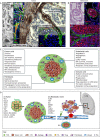Advances on the roles of tenascin-C in cancer
- PMID: 36102918
- PMCID: PMC9584351
- DOI: 10.1242/jcs.260244
Advances on the roles of tenascin-C in cancer
Abstract
The roles of the extracellular matrix molecule tenascin-C (TNC) in health and disease have been extensively reviewed since its discovery over 40 years ago. Here, we will describe recent insights into the roles of TNC in tumorigenesis, angiogenesis, immunity and metastasis. In addition to high levels of expression in tumors, and during chronic inflammation, and bacterial and viral infection, TNC is also expressed in lymphoid organs. This supports potential roles for TNC in immunity control. Advances using murine models with engineered TNC levels were instrumental in the discovery of important functions of TNC as a danger-associated molecular pattern (DAMP) molecule in tissue repair and revealed multiple TNC actions in tumor progression. TNC acts through distinct mechanisms on many different cell types with immune cells coming into focus as important targets of TNC in cancer. We will describe how this knowledge could be exploited for cancer disease management, in particular for immune (checkpoint) therapies.
Keywords: Immunity; Metastasis; Tenascin-C; Tumor.
© 2022. Published by The Company of Biologists Ltd.
Conflict of interest statement
Competing interests G.O. has filed patents on the discovery of TNC targeting peptides (WO2021233766A1) and nanobodies (EP21305210.3). All other authors declare no competing or financial interests.
Figures




Similar articles
-
Tenascin C in metastasis: A view from the invasive front.Cell Adh Migr. 2015;9(1-2):112-24. doi: 10.1080/19336918.2015.1008331. Cell Adh Migr. 2015. PMID: 25738825 Free PMC article. Review.
-
Modulating tenascin-C functions by targeting the MAtrix REgulating MOtif, "MAREMO".Matrix Biol. 2022 Apr;108:20-38. doi: 10.1016/j.matbio.2022.02.007. Epub 2022 Feb 26. Matrix Biol. 2022. PMID: 35227929
-
EWS-FLI1-mediated tenascin-C expression promotes tumour progression by targeting MALAT1 through integrin α5β1-mediated YAP activation in Ewing sarcoma.Br J Cancer. 2019 Nov;121(11):922-933. doi: 10.1038/s41416-019-0608-1. Epub 2019 Oct 25. Br J Cancer. 2019. PMID: 31649319 Free PMC article.
-
Investigating cell-type specific functions of tenascin-C.Methods Cell Biol. 2018;143:401-428. doi: 10.1016/bs.mcb.2017.08.023. Epub 2017 Dec 1. Methods Cell Biol. 2018. PMID: 29310789
-
Tenascin-C: A Key Regulator in Angiogenesis during Wound Healing.Biomolecules. 2022 Nov 15;12(11):1689. doi: 10.3390/biom12111689. Biomolecules. 2022. PMID: 36421704 Free PMC article. Review.
Cited by
-
Establishment and validation of an immune infiltration predictive model for ovarian cancer.BMC Med Genomics. 2023 Sep 28;16(1):227. doi: 10.1186/s12920-023-01657-x. BMC Med Genomics. 2023. PMID: 37759229 Free PMC article.
-
Chemokine Binding to Tenascin-C Influences Chemokine-Induced Immune Cell Migration.Int J Mol Sci. 2023 Sep 28;24(19):14694. doi: 10.3390/ijms241914694. Int J Mol Sci. 2023. PMID: 37834140 Free PMC article.
-
Discovery of immunotherapy targets for pediatric solid and brain tumors by exon-level expression.Nat Commun. 2024 May 3;15(1):3732. doi: 10.1038/s41467-024-47649-y. Nat Commun. 2024. PMID: 38702309 Free PMC article.
-
CAFs targeted ultrasound-responsive nanodroplets loaded V9302 and GLULsiRNA to inhibit melanoma growth via glutamine metabolic reprogramming and tumor microenvironment remodeling.J Nanobiotechnology. 2023 Jul 8;21(1):214. doi: 10.1186/s12951-023-01979-z. J Nanobiotechnology. 2023. PMID: 37420266 Free PMC article.
-
Negative regulation of lymphangiogenesis by Tenascin-C delays the resolution of inflammation.iScience. 2025 Jan 6;28(2):111756. doi: 10.1016/j.isci.2025.111756. eCollection 2025 Feb 21. iScience. 2025. PMID: 39925433 Free PMC article.
References
-
- Albacete-Albacete, L., Navarro-Lérida, I., López, J. A., Martín-Padura, I., Astudillo, A. M., Ferrarini, A., Van-Der-Heyden, M., Balsinde, J., Orend, G., Vázquez, J.et al. (2020). ECM deposition is driven by caveolin-1–dependent regulation of exosomal biogenesis and cargo sorting. J. Cell Biol. 219, e202006178. 10.1083/jcb.202006178 - DOI - PMC - PubMed
-
- Asparuhova, M. B., Ferralli, J., Chiquet, M. and Chiquet-Ehrismann, R. (2011). The transcriptional regulator megakaryoblastic leukemia–1 mediates serum response factor–independent activation of tenascin–C transcription by mechanical stress. FASEB J. 25, 3477-3488. 10.1096/fj.11-187310 - DOI - PubMed
Publication types
MeSH terms
Substances
Grants and funding
LinkOut - more resources
Full Text Sources
Medical
Miscellaneous

